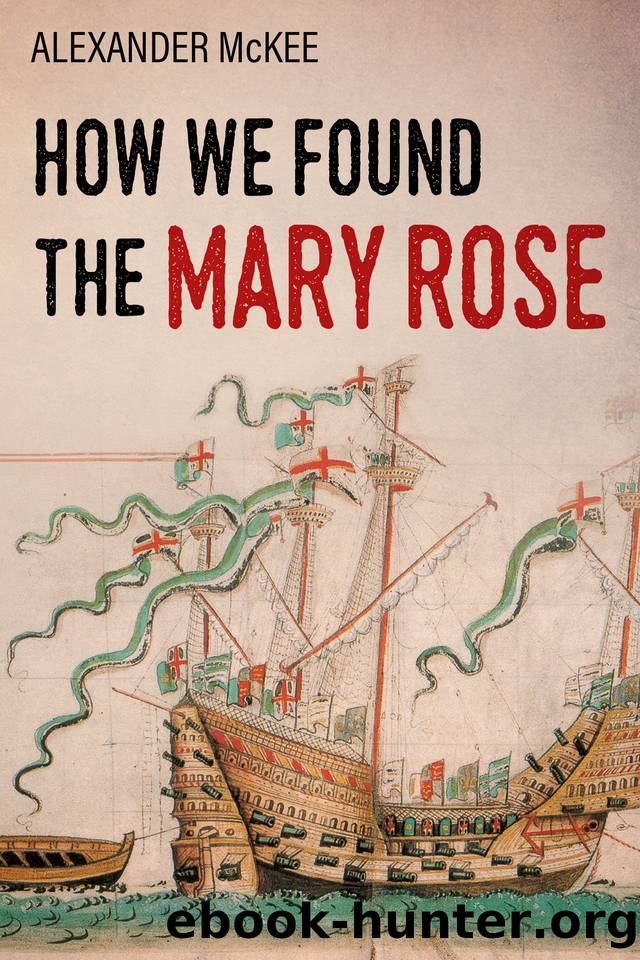How We Found the Mary Rose by McKee Alexander

Author:McKee, Alexander
Language: eng
Format: epub
Publisher: Sapere Books
Published: 2023-11-19T00:00:00+00:00
CHAPTER 8: âUNREMITTING TOILâ
Limited Excavations, 1971â1972
FOR THE last dig of 1970 we were without our firemen. We could see where they were working that day from the 20-miles long banner of smoke stretching from Bonchurch Down to Selsey Bill, marking the 42,000-ton oil tanker Pacific Glory burning south of the Wight. Even without their help, we were able to establish that the gun had been a single find; there was no solid structure near the hole from which it had come. Perhaps a castle had carried away, or either the Tudor salvors or John Deane had had an accident. Analysis pointed to the latter. But there were two surprises in store.
When the concretion was knocked off by the conservationist, Chris OâShea, he found that the bed and chamber were missing; we had only a barrel some 7½ feet long with a bore of 3¾ inches. At the breech end he uncovered primed gunpowder â and then gleaming metal! In the breech, wadded in hemp, was a shiny 3½-inch diameter iron shot. The last human hand to touch it before him had been a Tudor gunner in 1545. The thought awed him.
These comparatively weak built-up guns normally fired the lighter stone shot, not cast iron; but that too was to be explained. The first stage of conservation was a long immersion in an electrolytic bath. This removed the salt but substituted hydrogen, which had to be burnt out by placing the gun in an industrial oven for four hours at a temperature of exactly 220° Centigrade. After this had been done, the barrel was unsuccessfully X-rayed to find details of construction. Then the gamma ray or âcobalt bombâ method was tried, giving through wrought-iron a negative image similar to those obtained by Patrick Boardâs X-rays of teredoes through timber. The results gave me a shock. It was not a built-up gun! The rings were there all right, shrunk onto the barrel to hold it together. But there were no staves. Instead, the negatives showed a single white line â a weld! The barrel had been made from a single sheet of wrought-iron, instead of many thin strips, rolled round a core, and then rough-welded. This method would produce a stronger gun, explaining why it fired iron shot and enabling me to identify it among the strange names on the gun lists: a sling, known to cost much more than an ordinary iron piece. The gun was evidence of that bounding Tudor technology of which the Mary Rose herself was a part, but which the documents could only hint at.
The gun proved a potent weapon in the battle for support that winter of 1970â1971. Lord Mountbatten, who had done a great deal of aqualung diving in the Mediterranean, heard about our project and mentioned it to HRH The Duke of Edinburgh (who had been trained in the aqualung by the BS-AC) and to the Commander-in-Chief, Portsmouth. One direct result was that the Navy declared our site a âprohibited areaâ for surface vessels
Download
This site does not store any files on its server. We only index and link to content provided by other sites. Please contact the content providers to delete copyright contents if any and email us, we'll remove relevant links or contents immediately.
The Lonely City by Olivia Laing(4154)
Animal Frequency by Melissa Alvarez(3784)
All Creatures Great and Small by James Herriot(3556)
Walking by Henry David Thoreau(3264)
Exit West by Mohsin Hamid(3226)
Origin Story: A Big History of Everything by David Christian(3171)
COSMOS by Carl Sagan(2981)
How to Read Water: Clues and Patterns from Puddles to the Sea (Natural Navigation) by Tristan Gooley(2910)
Hedgerow by John Wright(2803)
The Inner Life of Animals by Peter Wohlleben(2794)
Origin Story by David Christian(2716)
How to Read Nature by Tristan Gooley(2690)
Project Animal Farm: An Accidental Journey into the Secret World of Farming and the Truth About Our Food by Sonia Faruqi(2684)
How to Do Nothing by Jenny Odell(2670)
Water by Ian Miller(2620)
A Forest Journey by John Perlin(2611)
The Plant Messiah by Carlos Magdalena(2478)
A Wilder Time by William E. Glassley(2384)
Forests: A Very Short Introduction by Jaboury Ghazoul(2358)
